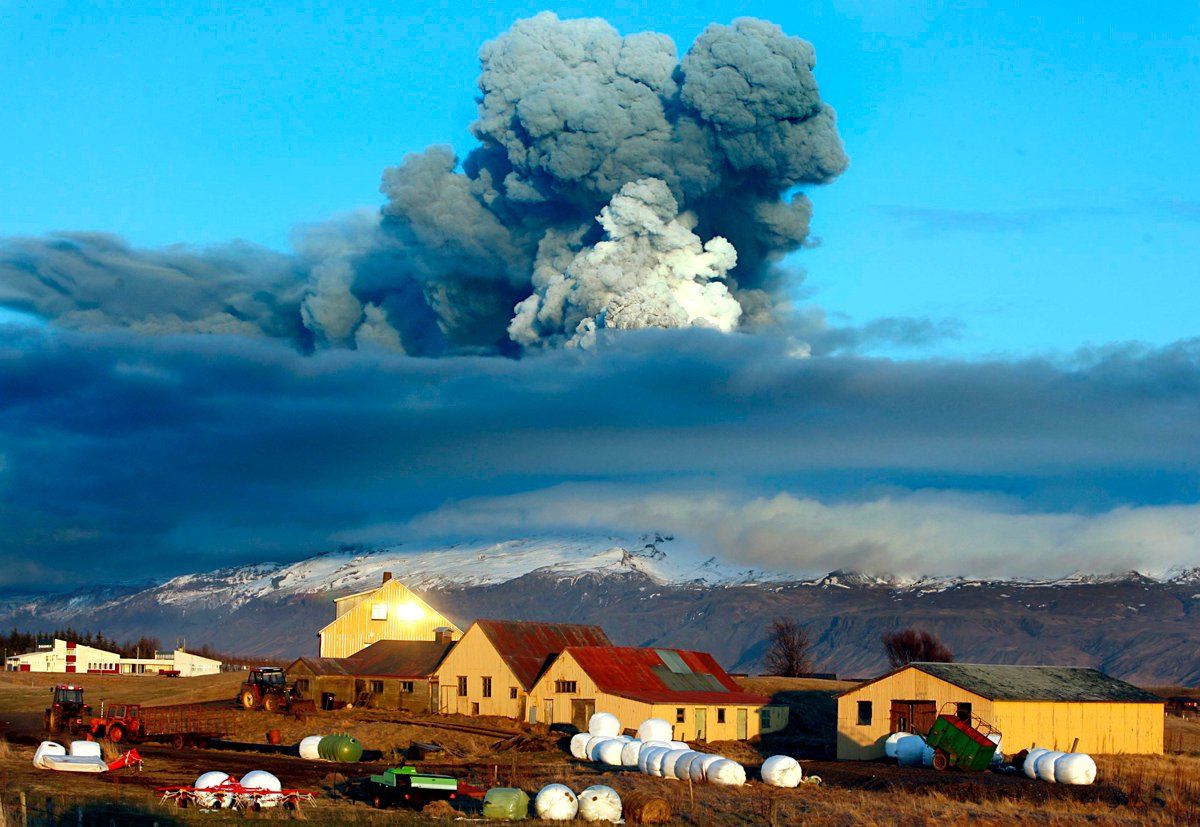
It is a stretch of southern Italy known as the Phlegraean Fields, or "burning fields." According to Greek mythology, this is where the god of fire, Hephaestus, made his home and where an thunderous battle between the Titans and the world's most powerful deities shook the earth. The ancient Romans said the entrance to Hades was also here, hidden beneath a serene lake.
Thousands of years later, the site is still subject to epic forces, but the story is more science than myth. The ground under the small fishing villages in this area around Naples is in constant slow movement because of volcanic activity deep below the surface. In Pozzuoli, a town just north of the city, the walls of the terra-cotta villages are falling down. The earth has risen and dipped more than 11 feet in the last decade, destroying roads, a hospital, and thousands of homes. Small tremors are common. On the outskirts of town, fields of boiling mud and dramatic sulfur spouts known as the Solfatara are a constant reminder that Naples sits on the Campi Flegrei caldera, or cauldron, one of the world's most dangerous volcanoes.
And while the legendary Mount Vesuvius is the best-known threat to greater Naples and its 4 million residents, Campi Flegrei, which stretches under the bay to the islands of Capri and Ischia, actually dwarfs Vesuvius in both size and potential threat. Giuseppe De Natale, head of research at the National Observatory for Geophysics and Volcanology, says the multi-crater Campi Flegrei caldera is a "supervolcano," with the eruptive potential to affect not just the immediate area but the entire planet.
De Natale is leading a consortium of volcano experts from 18 countries in a two-tier plan to drill into the underground caldera to find out just how imminent the threat is. Theirs is the largest drilling project in the history of volcanic research and one that De Natale believes is vital if they are to understand the magnitude of this submerged giant.
Unlike the relatively modest eruption of Eyjafjallajökull in Iceland in the spring of 2010, an eruption of Campi Flegrei would be beyond human imagination. It last erupted in 1538, killing dozens of people and creating the 1,500-foot-high Monte Nuovo. An eruption in this area more than 39,000 years ago had the same effect as a giant meteorite landing; it created the eight-mile wide depression that now forms the caldera.
"[An eruption of] Campi Flegrei could generate global, worldwide catastrophes," De Natale tells NEWSWEEK. "If it erupted, it would be really a complete catastrophe at a global scale, with millions of casualties, strong climate changes, perhaps causing a small ice age, and sterilization [contamination] of several hundred thousand square kilometers of European land for centuries."
The project has set off a passionate scientific and philosophical debate in a country where the idea of a volcano that could bury a city is more than just myth. Should they heed the rumblings under the earth and use science to evaluate the danger, possibly helping Naples avoid the tragedy that befell Pompeii? Or is it better not to tempt fate by drilling into the massive volcanic cauldron for fear that the work will disturb whatever combination of luck and geology has been keeping the city safe for thousands of years? The conflict has finallly bubbled over, prompting the mayor of Naples, Rosa Russo Iervolino, to delay the start of the project and call a meeting this week in Rome to determine whether it's safe to move forward.
In the pro-drilling camp there is the soft-spoken, professorial De Natale, who speaks of volcanoes as if they are human beings, who believes that the increasing rise and fall of the land around Naples is a precursor to a major volcanic event and that its exploration is essential to the survival of the people in this part of Italy.
On the other side are experts who say that De Natale's drilling project could compromise the integrity of the caldera, setting off a potentially deadly chain of events. Benedetto De Vivo, a professor of geochemistry at the University of Naples, says probing the area could rattle the volcano, leading to earthquakes, explosions, and devastating pollution if noxious gases are inadvertently released from the caldera. "The risks here are enormous," he tells NEWSWEEK. "You just don't do an experiment like this in an urban area."
Mayor Iervolino is torn. If she allows the drilling to go forward and there is so much as a slight tremor, she will forever be blamed for the carelessness of the decision. She says Naples has enough problems without the risk of man-made volcanic activity. Initially she signed off on the project, assuming that further research might protect the city from untold disaster, not cause it. But after hearing De Vivo's concerns she delayed the drilling and called the meeting in Rome. "The civil-protection authorities must promise me that this will not put my city at risk," she says. "Without that guarantee, there will be no drilling in any part of the caldera."
It may be impossible to make that promise definitively, but De Natale holds out hope that he and his team will get the chance to explore the immense caldera. The project, which was approved by the European Union in 2009, will cost nearly $14 million if completed.
The technology needed is as sophisticated as it is expensive. Drilling requires fiber-optic drill bits that can withstand temperatures up to 1,000 degrees Fahrenheit, even though projections are to stop drilling if temperatures exceed 600 degrees. Because the rigs are leased at about $28,000 a day, the work will take place around the clock to keep costs down and will be manned by about 25 scientists working in shifts.
The first phase consists of boring a pilot hole about 1,600 feet deep into the rim of the caldera on the grounds of the former Bagnoli steel mill between Pozzuoli and Naples. The rocks and soil taken during the drilling will be analyzed to produce the first-ever geological profile of Campi Flegrei. The scientists will implant sensors for precise underground seismic measurements that will provide crucial details about the volatility of the crater, possibly giving the residents of Naples warning of impending eruptions based on rising temperatures or underground magma flows.
If the conditions are right, the scientists will then initiate phase two, utilizing equipment generally used in oil exploration to drill down nearly 2.5 miles toward the center of the caldera. (By comparison, the recently freed Chilean miners were trapped at a depth of less than 2,000 feet.) The drill is never expected to reach the caldera's main magma reservoir, estimated to be at least 4 miles below the surface.
The exploration could reveal fractures in the earth that might lead to the release of noxious gas. It could also hit random magma reservoirs, says De Natale. But because the borehole will be relatively narrow, it would be almost impossible for magma to escape. There are still substantial risks, however. In Indonesia in 2006, a volcanic excavation was halted after the eruption of the Lusi mud volcano that killed 13 people and displaced 30,000. Scientists from Durham University in England and the University of California, Berkeley, have concluded that the drilling caused the eruption.
Stories like that are exactly what concerns De Vivo, who says the perforation of pockets of noxious gas by drilling into an unknown submerged volcano could cause explosions that might trigger seismic activity. The area of the old steel mill where the drilling bed is already set up had been allocated for a new park and residential area, and De Vivo worries that the drilling debris will contaminate the soil and render the area uninhabitable. "No one can say with any certainty what happens when you perforate supercritical fluids that have been under pressure for such a long time," he says. "If this were happening in a desert, sure, let's see what happens. But not under the city of Naples."
On the other hand, there's great potential in the exploration. De Natale argues that these fluids could eventually be harvested for geothermal energy, especially during the second phase of the project. Paolo Gasparini, an expert on geothermal studies at the University of Naples, believes that of all Italy's volcanoes, Campi Flegrei contains the most promising geothermal energy. Gasparini says that because Campi Flegrei is such a "hot" volcano, it could someday supply energy to all of Italy and beyond.
And because Campi Flegrei lies in one of the country's most impoverished regions, the possibility for job creation and economic growth through the potential export of geothermal energy is considerable. "The caldera is like a vast desert with ample potential for discovery," he says. "The opportunity to harvest this energy to sell is promising."
De Natale also says he sees indications that the volcano is stirring. "Campi Flegrei is changing, evolving, rising, falling, and getting hotter," he says. "It is very much alive, and we need to understand just what's going on down there."
De Vivo says that while he has nothing personal against De Natale, he cannot understand why his group would risk drilling into an area so close to the epicenter of the Neapolitan population. "The job of a scientist is to monitor the risks," he says. "We're not supposed to be creating them."
Uncommon Knowledge
Newsweek is committed to challenging conventional wisdom and finding connections in the search for common ground.
Newsweek is committed to challenging conventional wisdom and finding connections in the search for common ground.
About the writer
To read how Newsweek uses AI as a newsroom tool, Click here.








